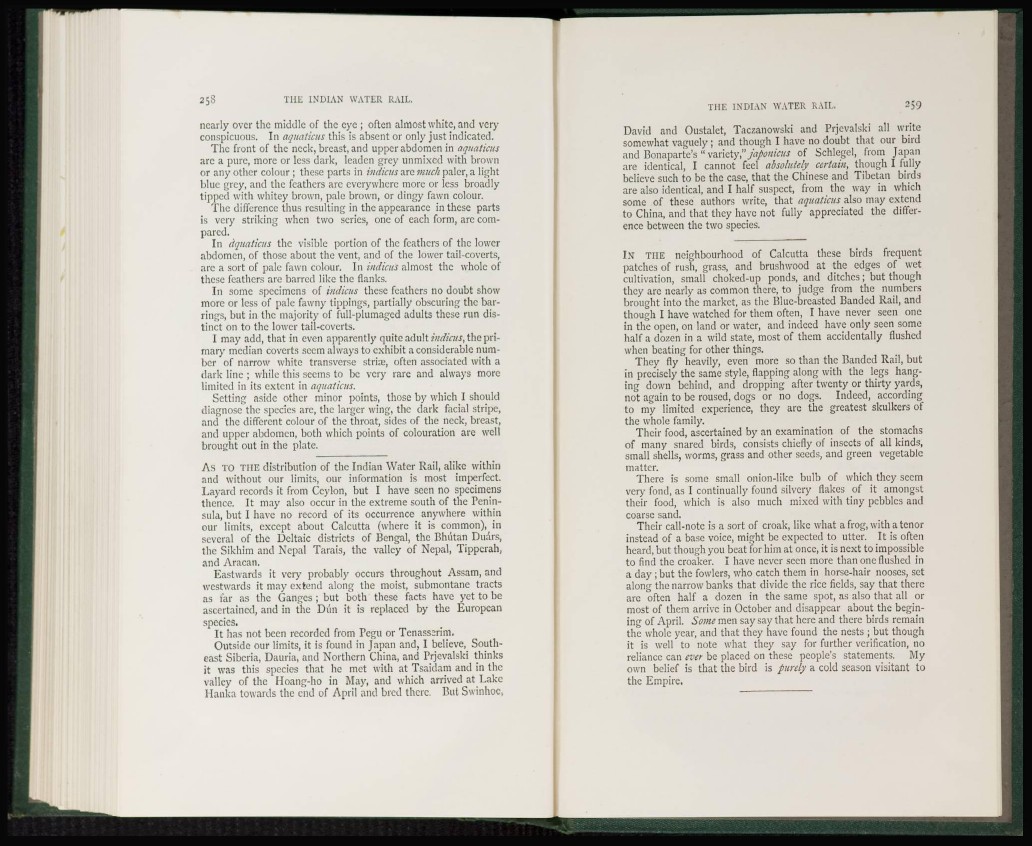
258 THE INDIAN WATER RAIL.
nearly over the middle of the eye ; often almost white, and very
conspicuous. In aquaticus this is absent or only just indicated.
The front of the neck, breast, and upper abdomen in aquaticus
are a pure, more or less dark, leaden grey unmixed with brown
or any other colour; these parts in indicus are much paler, a light
blue grey, and the feathers arc everywhere more or less broadly
tipped with whitcy brown, pale brown, or dingy fawn colour.
The difference thus resulting in the appearance in these parts
is very striking when two series, one of each form, arc compared.
In aquaticus the visible portion of the feathers of the lower
abdomen, of those about the vent, and of the lower tail-covcrts,
arc a sort of pale fawn colour. In indicus almost the whole of
these feathers are barred like the flanks.
In some specimens of indicus these feathers no doubt show
more or less of pale fawny tippings, partially obscuring the barrings,
but in the majority of full-plumagcd adults these run distinct
on to the lower tail-covcrts.
I may add, that in even apparently quite adult indicus, the primary
median coverts seem always to exhibit a considerable number
of narrow white transverse striae, often associated with a
dark line ; while this seems to be very rare and always more
limited in its extent in aquaticus.
Setting aside other minor points, those by which I should
diagnose the species arc, the larger wing, the dark facial stripe,
and the different colour of the throat, sides of the neck, breast,
and upper abdomen, both which points of colouration arc well
brought out in the plate.
As TO THE distribution of the Indian Water Rail, alike within
and without our limits, our information is most imperfect.
Layard records it from Ceylon, but I have seen no specimens
thence. It may also occur in the extreme south of the Peninsula,
but I have no record of its occurrence anywhere within
our limits, except about Calcutta (where it is common), in
several of the Deltaic districts of Bengal, the Bhutan Duars,
the Sikhim and Nepal Tarais, the valley of Nepal, Tippcrah,
and Aracan.
Eastwards it very probably occurs throughout Assam, and
westwards it may extend along the moist, submontane tracts
as far as the Ganges ; but both these facts have yet to be
ascertained, and in the Dun it is replaced by the European
species.
It has not been recorded from Pegu or Tenasssrim.
Outside our limits, it is found in Japan and, I believe, Southeast
Siberia, Dauria, and Northern China, and Prjevalski thinks
it was this species that he met with at Tsaidam and in the
valley of the Hoang-ho in May, and which arrived at Lake
Ilanka towards the end of April and bred there. But Swinhoe,
THE INDIAN WATER RAIL. 259
David and Oustalet, Taczanowski and Prjevalski all write
somewhat vaguely; and though I have no doubt that our bird
and Bonaparte's "variety," japonicus of Schlegel, from Japan
are identical, I cannot feel absolutely certain, though I fully
believe such to be the case, that the Chinese and Tibetan birds
are also identical, and I half suspect, from the way in which
some of these authors write, that aquaticus also may extend
to China, and that they have not fully appreciated the difference
between the two species.
IN THE neighbourhood of Calcutta these birds frequent
patches of rush, grass, and brushwood at the edges of wet
cultivation, small choked-up ponds, and ditches; but though
they are nearly as common there, to judge from the numbers
brought into the market, as the Blue-breasted Banded Rail, and
though I have watched for them often, I have never seen one
in the open, on land or water, and indeed have only seen some
half a dozen in a wild state, most of them accidentally flushed
when beating for other things.
They fly heavily, even more so than the Banded Rail, but
in precisely the same style, flapping along with the legs hanging
down behind, and dropping after twenty or thirty yards,
not again to be roused, dogs or no dogs. Indeed, according
to my limited experience, they are the greatest skulkers of
the whole family.
Their food, ascertained by an examination of the stomachs
of many snared birds, consists chiefly of insects of all kinds,
small shells, worms, grass and other seeds, and green vegetable
matter.
There is some small onion-like bulb of which they seem
very fond, as I continually found silvery flakes of it amongst
their food, which is also much mixed with tiny pebbles and
coarse sand.
Their call-note is a sort of croak, like what a frog, with a tenor
instead of a base voice, might be expected to utter. It is often
heard, but though you beat for him at once, it is next to impossible
to find the croaker. I have never seen more than one flushed in
a day ; but the fowlers, who catch them in horse-hair nooses, set
along the narrow banks that divide the rice fields, say that there
are often half a dozen in the same spot, as also that all or
most of them arrive in October and disappear about the begining
of April. Some men say say that here and there birds remain
the whole year, and that they have found the nests ; but though
it is well to note what they say for further verification, no
reliance can ever be placed on these people's statements. My
own belief is that the bird is purely a cold season visitant to
the Empire.